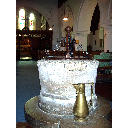The Interior
The two most notable features are the roof and the south arcade. The massive mediaeval roof has two great tie-beams supporting octagonal crown-posts from each of which branch two braces. This structure is generally confined to south-east England. The late 12th century arcade has two large round piers and three slightly pointed arches. The soffit (underside) of the western-most arch has traces of 12th century painted decoration in red pigment.
The tall, four-centred tower arch with polygonal jambs is later 15th century perpendicular; the small door and doorway to the stair turret are also late 15th century as are the moulded ceiling-timbers. Notice the fove guide holes in the ceiling for bellropes.
The North Chapel
Is entered by the lovely continuous 14th century arch. There is a simple brass chandelier of 1728, and a mediaeval piscina. The altar is a memorial to the village dead of the Great War.
The chapel was formerly the responsibility of the Lords of the manor whose big private pew is shewn in Scott's plan. In the 17th and 18th centuries the manor was held by the Scawens , many of whom were interred in a vault (now closed) below the chapel floor. They were buried in linen for which they paid a levy of £50; everyone else was buried in wool, a government stipulation to encourage the wool industry. A huge and elaborate memorial to them occupied much space in the chapel, but disappeared during the restoration.
The Chancel
There are head corbels on either side of the 14th century chancel arch. There is a half a 15th century poppyhead pew-end by the north wall. (The only pre-reformation woodwork in the church apart from the two tower doors.) Most of the chancel was rebuilt in C13th style, possibly enclosing earlier walls, in the mid-C19th. There is a 19th century mosaic of flowers on the floor of the sanctuary.
Chancel Monuments
- Two purbeck marble slabs (partly under the organ platform)
(a) with indents for brasses of a civilian, his wife, 2 sons and 2 daughters (c.1490)
(b) slab with indent containing rivets and plugholes for brass.
Appropriated for Robert Nanney, Rector, who died in 1734.
- Centre chancel:(a) Tournai marble slab, to Sarah Milton, 1637 mother of the poet
John Milton
- On the north wall is a marble cartouche monument, with a curved face, to Robert Nanney who married into the Scawen family. It was transferred from the south wall when the organ was installed by J W Walker & Son of London in 1880.
The Organ
The organ of 1880 cost £305. The pointed tops to the pipes and the stencilled decoration are unusual; they were made at the insistance of Avery Tyrrel of Berkyn Manor who defrayed the cost. It was overhauled by J W Walker in 1996 at a cost of £20,887 38p!
The Bells
The oldest bell ( a rare example of one cast during the civil war) is inscribed "Feare God 1647". A sixth bell, (the treble - the smallest bell) was added in 1897 to commemorate Queen Victoria's Diamond Jubilee. It cost £200, provided by the premium for the least of the Five Bells public house, at that time owned by the Church Lands Trustees.
List of Rectors
Near the font. The illuminated list of 1950 shows the succession from 1208 to 1948.
Glass
Most of the painted glass dates from 1880-1905 and is by C E Kempe. His wheatsheaf trademark can be seen in two of the chancel windows.
The three East Chancel wall lancets depict the three figures of the Crucifixion (The Virgin, Christ and St John) which were formerly shewn on mediaeval roodscreens. Each lancet also shows a poet in its lower part:
- to the left is Caedmon (dc 680) the earliest English poet
- in the centre is King David composing the psalms
- on the right, writing Paradise Lost, is John Milton who lived (from 1632-1638) in the village to which his father (a London lawyer) had retired.
This was installed in 1927 at a cost of £66 14s. 5d, by the Datchet and Slough Electricity Supply Company. The frames of the earlier oil lamps were retained to suppor tthe electricity bulbs, which they still do. The porch lantern still incorporates a copper oil lamp.
The Porch and North Doorway
The 16th century porch, rebuilt in the 1870s is timber-studded above a brick plinth. The external oak doors below the pretty cusped bargeboards are of 1970. The proch protects the church's architectural gem, the North doorway.
This richly decorated C12th doorway has a semi circular arch with four orders of decoration and is flanked by a pair of shafts with scallopped capitals. The two orders of bead-and-reel and chevron are unusual in that they extend to the ground. An interesting feature is that the voussoirs (wedge-shaped stones) are alternativing yellow limestone and white clunch. The north position and the softness of the clunch stone means that the door

